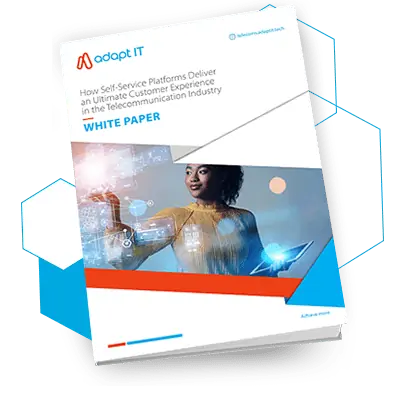Dans le monde des affaires d'aujourd'hui, ce n'est un secret pour personne qu'il est plus coûteux d'acquérir de nouveaux clients que de conserver les clients actuels, et cela est vrai pour le secteur des télécommunications. La question est de savoir comment réduire le taux de désabonnement et continuer à vendre plus cher à votre clientèle existante. La réponse réside dans l'analyse avancée. Nous examinons ci-dessous comment les logiciels d'analyse avancée permettent aux entreprises de télécommunications de faire face à l'avenir et de réduire le taux de désabonnement.
Table des matières
ToggleL'évolution des besoins des consommateurs
Les consommateurs d'aujourd'hui ne sont pas les mêmes que ceux d'il y a cinq ans. Les choses ont changé, la transformation numérique continue de modifier notre façon de vivre et de travailler, ce qui modifie le comportement, les besoins et les souhaits des clients.
Les entreprises de télécommunications sont particulièrement bien placées pour répondre à ces besoins spécifiques, d'autant plus que l'utilisation du téléphone portable est devenue une nécessité pour la vie personnelle et professionnelle des clients. Les entreprises de télécommunications fournissent ce que beaucoup considèrent comme un service nécessaire dans le monde d'aujourd'hui. Le problème est que le marché est incroyablement concurrentiel. En tant qu'entreprise de télécommunications, vous devez être au sommet de votre art et connaître votre marché, la façon dont vos clients utilisent le réseau et ce qu'ils recherchent. Cette connaissance vous permet d'adapter, d'ajuster et d'innover votre entreprise pour mieux répondre aux besoins et aux désirs changeants de vos clients.
Si vous gérez correctement cette situation, vous pouvez réduire le taux de désabonnement, ce qui est vital pour le succès de l'entreprise de télécommunications. Vous vous demandez peut-être comment une entreprise de télécommunications peut obtenir les informations nécessaires pour réduire la perte de clients ? La réponse se trouve dans l'analyse avancée.
Définition de l'analyse avancée et pourquoi nous avons besoin de l'analyse avancée dans les télécommunications ?
L'analytique avancée et le big data sont devenus synonymes du monde des affaires, et pour une bonne raison. Avant d'examiner l'impact de l'analytique avancée sur une entreprise de télécommunications, nous devons définir l'analytique avancée.
Gartner définit l'analyse avancée comme l'examen autonome ou semi-autonome de données ou de contenu à l'aide de techniques et d'outils sophistiqués, généralement au-delà de la veille économique (BI) traditionnelle, afin de découvrir des informations plus approfondies, de faire des prédictions ou de générer des recommandations. Les techniques analytiques avancées comprennent l'exploration de données et de textes, l'apprentissage automatique, la comparaison de modèles, la prévision, la visualisation, l'analyse sémantique, l'analyse de sentiments, l'analyse de réseaux et de grappes, les statistiques multivariées, l'analyse de graphiques, la simulation, le traitement d'événements complexes et les réseaux neuronaux.
Ainsi, l'analyse avancée aide les opérateurs télécoms à donner un sens à des données complexes afin d'identifier des modèles, de diagnostiquer des problèmes et de prévoir des solutions.
En termes simples, l'analyse avancée désigne généralement le processus consistant à prendre des données brutes à partir de plusieurs sources de données de réseau différentes, en utilisant l'apprentissage automatique et l'intelligence artificielle pour collecter, stocker, nettoyer, organiser et interpréter les données en des informations exploitables et significatives liées à chaque aspect de l'entreprise, qu'il s'agisse des performances du réseau, du comportement des clients, des opérations, des performances, de la prestation de services, etc.
Armé de ces informations, un Telco peut :
- Améliorer la prise de décision car ils disposent de toutes les données actuelles et historiques nécessaires pour identifier les tendances et les repères possibles ainsi que les problèmes ou les possibilités d'amélioration.
- Amélioration de l'agilité et de la réactivité car les données sont disponibles quasiment en temps réel, ce qui permet aux opérateurs télécoms d'identifier les problèmes, d'atténuer les risques et de trouver des solutions rapidement.
- Assurer un meilleur retour sur investissement (ROI) car les données fournissent les informations nécessaires pour mieux cibler les segments de clientèle, ce qui améliore la rentabilité globale.
- Permet à une société de télécommunications d'être parfaitement préparée à des circonstances inattendues en fournissant des informations qui mettent en évidence les tendances à venir et identifient les éléments auxquels la société de télécommunications peut répondre.
- Améliorer le partage des données et la responsabilisation des employés en fournissant une vue globale des données entre les départements et les opérations, ce qui favorise la communication et vise à aider à identifier et à résoudre les problèmes avant qu'ils ne surviennent.
- Améliorer la satisfaction et la fidélisation des consommateurs, qui sont les piliers du succès d'une société de télécommunications, en identifiant les besoins, les souhaits et les problèmes des clients et en y apportant des solutions.
Il ressort clairement de ce qui précède que l'analyse avancée joue un rôle essentiel dans l'activité des opérateurs de télécommunications et dans leur capacité à rester performants. L'un des points mentionnés ci-dessus est essentiel à cet égard et doit être parfaitement compris. Il s'agit de l'acquisition et de la fidélisation des clients, que nous développons ci-dessous.
Acquisition et rétention des clients
La question de savoir ce qui est le plus important pour une entreprise de télécommunications, l'acquisition ou la fidélisation de la clientèle, a fait l'objet de nombreux débats. De nombreuses entreprises de télécommunications se sont concentrées sur l'acquisition de clients par le passé, mais la situation est en train de changer. L'accent a été déplacé de l'acquisition à la fidélisation de la clientèle pour deux raisons. La première est qu'il est plus coûteux d'acquérir un nouveau client que de le fidéliser, et la seconde est que lorsque l'accent est mis sur la fidélisation des clients, il y a généralement une réduction du taux de désabonnement. Ces deux éléments ont une incidence considérable sur le secteur des télécommunications.
La recherche 77 % des clients se rétractent plus rapidement qu'il y a trois ans, ce qui signifie que la fidélisation de la clientèle dans le secteur des télécommunications est plus difficile à atteindre que jamais. Les entreprises de télécommunications doivent donc redoubler d'efforts pour réduire le taux de désabonnement et accroître la fidélisation des clients.
L'analyse avancée s'avère être un outil précieux pour résoudre ce problème pour les opérateurs télécoms.
Réduire les désabonnements grâce à l'analyse avancée
Pour analyser les exemples d'analyses avancées et leur impact sur le taux de désabonnement, nous devons définir ce qu'est le taux de désabonnement. Le taux de désabonnement est aussi souvent appelé le taux de désabonnement, qui est le taux auquel les clients cessent de faire affaire avec une organisation. Il mesure donc la perte d'abonnés de l'entreprise sur une période donnée. Cette perte peut être attribuée à :
- L'annulation d'un abonnement ou d'un service.
- Le déclassement des abonnements.
- Les clients quittent votre entreprise au cours d'une période donnée, généralement les 30 derniers jours.
Le taux de résiliation des clients a un impact direct sur le taux de résiliation des revenus. La perte de revenus correspond au montant des revenus bruts perdus sur une période donnée. Lorsque vous subissez une perte de clientèle et que vous ne pouvez pas acquérir de nouveaux clients pour combler cette perte, vous subissez une perte de revenus.
Il ressort clairement de ce qui précède que le taux de désabonnement a un impact direct sur la rentabilité et la croissance des entreprises de télécommunications, d'autant plus que l'acquisition de nouveaux clients est très coûteuse.
Alors comment faire en sorte qu'un client reste avec vous en tant qu'opérateur télécom ? La réponse réside dans l'offre d'une excellente expérience client et dans la réponse aux besoins des clients. L'expérience globale du client est ce qui empêche les gens de changer de fournisseur. Pour cela, il faut comprendre qui sont vos clients et ce qu'ils apprécient. Vous vous demandez peut-être comment le découvrir ? La réponse est l'analyse avancée.
Comment réduire la perte de clients ?
L'analyse avancée constitue la base de la fidélisation des clients et réduit donc le taux de désabonnement, de trois manières puissantes, en fournissant :
Une compréhension détaillée des clients et de la segmentation de la clientèle
Des analyses avancées permettent de suivre et de gérer l'ensemble du cycle de vie des clients, ce qui permet aux fournisseurs de prendre les meilleures décisions pour fidéliser leurs clients. Le logiciel vous permet d'accéder à tous les détails dont vous avez besoin sur les abonnés :
- Où vivent-ils ?
- Combien dépensent-ils ?
- Quel appareil utilisent-ils ?
- Quelle tour de base utilisent-ils ?
- Quels sont les services qu'ils utilisent ?
L'analyse avancée offre une vue du comportement des clients, des tendances et des schémas d'utilisation, ce qui permet aux entreprises de concevoir des offres efficaces, de proposer des prix compétitifs et de prendre des mesures immédiates, le cas échéant, pour fidéliser les abonnés.
Alertes en cas de désabonnements potentiels
Les solutions logicielles d'analyse des télécommunications fournissent des alertes sur les désabonnements potentiels, car les personnes cessent d'utiliser le service avant d'annuler leur abonnement. Cela permet aux fournisseurs de s'adapter et de réagir immédiatement pour conserver l'abonné.Les fournisseurs peuvent accéder à des informations sur :
- Changements dans le comportement d'achat de services à valeur ajoutée.
- Changements dans le ratio de trafic.
- Changements dans l'emplacement le plus utilisé.
- Analyse des tendances pour les mouvements des abonnés entrant et sortant du réseau.
Tous les sites CDRVOIP, LTE, Roaming, IoT, VAS, et tout autre enregistrement d'événement peuvent être analysés en temps réel pour découvrir des modèles émergents dans les services ou le comportement des abonnés.
Segmentation de la clientèle
Les clients veulent de la personnalisation, et alors que fournir un service unique et personnalisé à un client spécifique nécessiterait trop de ressources, vous pouvez regrouper les clients en segments spécifiques pour leur fournir une approche personnalisée. Sur la base de caractéristiques et de comportements spécifiques, les abonnés peuvent être placés dans des segments pertinents afin d'éviter la perte de clients.
Par exemple, les abonnés qui manquent régulièrement de données peuvent se voir proposer des packs d'utilisation de données plus élevés à un tarif réduit ou être informés sur les forfaits qui peuvent leur faire économiser de l'argent. L'analyse avancée permet aux opérateurs télécoms de regrouper leurs clients afin de réaliser un marketing plus efficace et d'offrir une expérience client plus riche.
Comment Adapt IT Telecoms CDRlive aide à réduire le taux de désabonnement.
Il ne fait aucun doute que les analyses avancées jouent un rôle important en aidant les opérateurs télécoms à réduire le taux de désabonnement. Laissez-nous vous présenter notre solution d'analyse avancée basée sur la technologie CDRlive.
Cette plateforme convertit les données, qui, pour les opérateurs de télécommunications, se présentent sous la forme d'enregistrements de données d'appel (CDR) et d'autres données essentielles du réseau, en informations exploitables et précieuses que l'entreprise peut utiliser en temps quasi réel. Ces informations fournissent des données relatives à la façon dont les utilisateurs se servent d'un système téléphonique, d'Internet, des appels vidéo, des SMS, etc. Les CDR fournissent spécifiquement des centaines de champs pour chaque enregistrement d'appel et des informations relatives à chaque type d'appel.
Ces données, en l'état, ne sont pas structurées, mais en utilisant l'intelligence artificielle et l'apprentissage automatique, cette technologie transforme les données CDR en informations compréhensibles et précieuses. Ces données en temps quasi réel sont propres, cataloguées et fiables, ce qui les rend parfaites pour la production de rapports ainsi que pour l'exploration des données techniques et analytiques relatives au suivi des désabonnements. Les informations sont ensuite transformées en analyses présentées sur un tableau de bord facile à interpréter. Ces analyses vous permettront de :
- Comprenez vos propres facteurs de désabonnement et ceux de vos concurrents.
- Fournit les facteurs de déclin et de désabonnement par segment et par emplacement géographique.
- Diminuez vos coûts de rétention.
En outre, la valeur associée à cette solution est la capacité d'analyser les données relatives au comportement, aux tendances et aux cycles de vie des clients, entre autres. Ces informations vous permettent, en tant qu'opérateur télécom, de vous assurer que vos produits et services répondent aux besoins des clients, que vos niveaux de service garantissent une bonne expérience client et que vous êtes à l'écoute de ce que veulent vos clients. Grâce à ces informations, vous pouvez vendre des produits et des services à un prix plus élevé, développer de nouvelles offres qui répondent à leurs besoins, résoudre rapidement tout problème et, au final, réduire le taux de désabonnement.
Conclusion
Les clients et le marché des télécommunications, en général, évoluent, principalement en raison de plusieurs facteurs, dont la transformation numérique. Ce changement s'est accompagné d'une augmentation de la concurrence au sein du marché, ce qui rend essentiel pour les Telcos de se concentrer sur la fidélisation des clients pour assurer l'avenir de leur entreprise. L'une des façons de réduire le taux de désabonnement et d'augmenter la fidélisation des clients est de recourir à l'analyse avancée. Les solutions d'analyse avancée, comme notre plateforme CDRlive, permettent aux opérateurs de télécommunications de mieux connaître les consommateurs, leurs comportements, leurs habitudes d'achat, les tendances, etc. Ces informations sont ensuite utilisées pour améliorer les offres et les services proposés aux clients, l'expérience client et la satisfaction des clients, ce qui réduit le taux de désabonnement. Pour en savoir plus sur notre technologie CDRlive, téléchargez le livre blanc ici.
Explorez la puissance du CDR

En tant que responsable mondiale du marketing et du développement commercial, forte de 20 ans d'expérience, l'expertise d'Agnieszka réside dans la mise en œuvre pratique de stratégies marketing numériques et traditionnelles pour les entreprises B2C et B2B. Grâce à son approche stratégique à long terme, axée sur le client, et à son expérience en matière de stratégie de marque, elle continue de développer des plans marketing innovants qui donnent des résultats significatifs. Travaillant désormais dans le secteur du SaaS, elle supervise une multitude de solutions au sein de l'industrie des télécommunications, notamment l'expérience client et le libre-service, les SVA, le NextGen, l'IoT, le FinTech et les analyses avancées.









